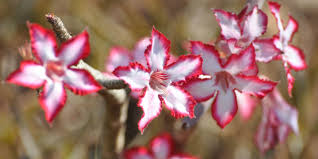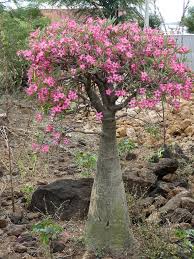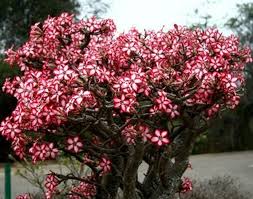Adenium multiflorum
Adenium multiflorum
Couldn't load pickup availability
Adenium multiflorum, also known as the impala lily or winter-blooming adenium, is a succulent shrub native to southern Africa. It is prized for its swollen, water-storing trunk, called a caudex, and its striking clusters of flowers. The plant is well-adapted to arid conditions
- Flowers: The prominent flowers are typically star-shaped, with five petals that have wavy margins and pointed lobes. They appear in clusters during the winter months, often before the leaves emerge. The flower colors range from pink and red to white, and some are bicolored with a dark red margin and a white or pink center.
- Caudex: A distinguishing feature of A. multiflorum is its swollen, bottle-shaped base. This caudex acts as a water storage organ, allowing the plant to survive long periods of drought. Younger plants may have their caudex buried to encourage development, while it is often exposed on mature plants.
- Leaves: The fleshy, oval-shaped leaves are arranged in a spiral pattern and clustered at the tips of the branches. They are a glossy green on the top surface and paler underneath. The plant is deciduous and typically loses its leaves during its dormant, dry season.
-
Sunlight: This succulent prefers bright, direct sunlight for several hours a day.
- Soil: Well-draining soil is crucial to prevent root rot. A mix for cacti and succulents is ideal.
- Watering: Water moderately during the growing season (spring and summer), allowing the soil to dry out completely between waterings. Water very sparingly during its winter dormancy.
- Temperature: It is not frost-tolerant and requires warm temperatures, ideally above 10–15°C (50–59°F).
-
Propagation: The plant can be propagated by seed or stem cuttings. Growing from seed will produce a plant with a caudex, while a cutting will not
- Toxicity: The milky sap of A. multiflorum is toxic and can be harmful to humans and animals if ingested.
- Arrow poison: Historically, the toxic latex has been used as an arrow and fish stunning poison by indigenous people in its native region.
- Medicinal uses: While toxic, other Adenium species have been traditionally used in some cultures to treat skin diseases, joint pain, and venereal diseases.
Price is for 5 seeds



Collapsible content
Fair Use Disclaimer
Our website may contain content not authorized for use by its owner but use of this material falls under the guidelines of fair use (They are for educational purposes only to show the plant only).
If you want to find our more or own any images displayed on our website and disagree with our assessment it constitutes 'fair use' please click here.



